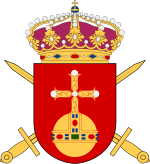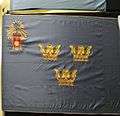Uppland Regiment
The Uppland Regiment (Swedish: Upplands regemente), designation I 8, was a Swedish Army infantry regiment that traced its origins back to the 16th century. It was disbanded in 1957. The regiment's soldiers were originally recruited from the province of Uppland, and it was later garrisoned there.
| Uppland Regiment | |
|---|---|
| Upplands regemente | |
 | |
| Active | 1626–1709, 1709–1957 |
| Country | |
| Allegiance | Swedish Armed Forces |
| Branch | Swedish Army |
| Type | Infantry |
| Size | Regiment |
| Part of | 4th Military District (1833–1888) 5th Military District (1888–1893) 5th Army Division (1893–1901) V Army Division (1902–1927) Eastern Army Division (1928–1936) IV Army Division (1937–1942) IV Military Area (1942–1957) |
| Garrison/HQ | Uppsala |
| Colors | Red and yellow |
| March | "Utgångsmarsch" (Bergström)[note 1] |
| Battle honours | Varberg (1565), Narva (1581), Lützen (1632), Warszawa (1656), Fredriksodde (1657), Tåget över Bält (1658), Rügen (1678), Düna (1701), Kliszow (1702), Holovczyn (1708), Helsingborg (1710), Svensksund (1790) |
History
The regiment has its origins in fänikor (companies) raised in Uppland in the 1550s and 1560s. In 1617, these units—along with fänikor from the nearby provinces of Dalarna and Västmanland—were organised by Gustav II Adolf into Upplands storregemente, of which eight of the total 24 companies were recruited in Uppland. Upplands storregemente consisted of three field regiments, of which Uppland Regiment was one. Sometime around 1623, the grand regiment was permanently split into 3 smaller regiments, of which Uppland Regiment was one.
The regiment was officially raised in 1626 although it had existed since 1623. Upplands regemente was one of the original 20 Swedish infantry regiments mentioned in the Swedish constitution of 1634. The regiment's first commander was Nils Brahe. It was allotted in 1682 as one of the first regiments to be so.
The regiment was given the designation I 8 (8th Infantry Regiment) in a general order in 1816. Uppland Regiment was renamed Uppland Infantry Regiment in 1904 to distinguish it from Uppland Artillery Regiment. The regiment was garrisoned in Uppsala from 1912. In 1928, the regiment regained its old name. The regiment was disbanded in 1957. The signal regiment Uppland Signal Regiment was renamed to Uppland Regiment in 1974, but does not trace its origins from the original regiment, even though the victory names have been transferred to it.
Campaigns
- ?
Organisation
|
|
Heraldry and traditions
Colours, standards and guidons
The regiment has carried a number of colour over the years. On 3 July 1855, His Majesty the King Oscar I presented a new colour to the regiment's two battalions. The two colours only had two battle honours, Lützen and Kliszow. On 27 September 1955, His Majesty the King Gustaf VI Adolf presented a colour, which replaced the 1855 colours. The new colour had 12 battle honours. The colour was on 30 March 1957 handed over to the Uppland Signal Regiment, which carried it alongside its original colour.[2]
 The 1935 colour. The provincial badge of Uppland was added in 1959 in the upper inner corner, where initially the lesser coat of arms of Sweden was.
The 1935 colour. The provincial badge of Uppland was added in 1959 in the upper inner corner, where initially the lesser coat of arms of Sweden was.
Coat of arms
The coat of the arms of the Uppland Regiment (I 8). It was used by Uppland Group (Upplandsgruppen) 2000–2005 and by the Uppland and Västmanland Group (Upplands- och Västmanlandsgruppen) since 2005. Blazon: "Gules, the provincial badge of Uppland, an orb or, banded and ensigned with a cross-crosslet. The shield surmounted two swords in saltire or".[3]
Medals
In 1934, the Kungl. Upplands regementes (I 8) förtjänstmedalj ("Royal Uppland Regiment (I 8) Medal of Merit") in gold, silver and bronze (UpplregGM/UpplregSM/UpplregBM) were established.[4][5][6]
 Royal Uppland Regiment Medal of Merit from 1938.
Royal Uppland Regiment Medal of Merit from 1938. Royal Uppland Regiment Medal of Merit from 1938.
Royal Uppland Regiment Medal of Merit from 1938.
Heritage
Following the decision of the Riksdag on the disbandment of the regiment, a ceremony was held on 10 March 1957.[7] After the regiment was disbanded, the regiment's traditions were continued Uppland Signal Regiment, which also assumed the name of Uppland Regiment.[2] From 2007, the traditions of the regiment were passed on to the Command and Control Regiment. From 1 July 2013, the regimental traditions will be continued by the Uppland Battalion, part of the Uppland and Västmanland Group (Upplands- och Västmanlandsgruppen).[8]
Commanding officers
Regimental commander active from 1698 to 1957.[9]
- 1698–1705: O W Löwe(n)
- 1705–1706: J V von Daldorff
- 1706–1709: G F de Frietzcyk
- 1709–1709: G Stiernhöök
- 1709–1710: J Braun
- 1710–1710: C Ekeblad
- 1710–1711: G Ribbing
- 1711–1721: G W Fleetwood
- 1721–1723: G Oxenstierna
- 1723–1728: O J Koskull
- 1728–1730: O W Staël von Holstein
- 1730–1737: O M Wolffelt
- 1737–1741: W L Taube
- 1741–1748: C M de Laval
- 1748–1757: Fredrik Henrik Sparre
- 1757–1759: C J Mörner
- 1759–1772: T G Rudbeck
- 1772–1772: Per Scheffer
- 1772–1788: Fabian Casimir Wrede
- 1788–1791: Fabian Wrede
- 1791–1794: Adam Ludvig Lewenhaupt
- 1794–1810: Adolf Ludvig von Schwerin
- 1810–1816: Gustaf Olof Lagerbring
- 1816–1825: C A Hård
- 1825–1837: S D Sparre
- 1837–1854: C L Daevel
- 1854–1860: A L Rappe
- 1860–1862: A F Z Reuterskiöld
- 1862–1865: J A Sundmark
- 1865–1881: Otto Mauritz von Knorring
- 1881–1888: S G R von Bahr
- 1888–1899: L W Stiernstedt
- 1899–1905: Bengt Erland Eberhard von Hofsten
- 1905–1911: Curt Johan Elof Rosenblad
- 1911–1923: Claës Sundin
- 1923–1928: Bo Boustedt
- 1928–1935: Carl Schöning
- 1935–1940: Helmer Bratt
- 1940–1942: Sven Ryman
- 1942–1950: Olle Norman
- 1950–1957: Carl Axel Grewell
Names, designations and locations
| Name | Translation | From | To | |
|---|---|---|---|---|
| Kungl. Upplands regemente | Royal Uppland Regiment | 1626-??-?? | – | 1709-07-01 |
| Kungl. Upplands regemente | Royal Uppland Regiment | 1709-??-?? | – | 1904-12-07 |
| Kungl. Upplands infanteriregemente | Royal Uppland Infantry Regiment | 1904-12-08 | – | 1927-12-31 |
| Kungl. Upplands regemente | Royal Uppland Regiment | 1928-01-01 | – | 1957-03-31 |
| Avvecklingsorganisation | Decommissioning Organisation | 1957-04-01 | – | 1957-09-30 |
| Designation | From | To | ||
| № 8 | 1816-10-01 | – | 1914-09-30 | |
| I 8 | 1914-10-01 | – | 1957-03-31 | |
| Locations | From | To | ||
| Kronoparken | 1600s | – | 1912-09-09 | |
| Örsundsbro | 1680-??-?? | – | 1912-09-09 | |
| Polacksbacken | 1681-??-?? | – | 1912-09-09 | |
| Söderby/Uppsala-Näs | 1881-??-?? | – | 1912-09-09 | |
| Uppsala Garrison | 1912-09-10 | – | 1957-09-30 |
See also
Footnotes
- The march was adopted around 1890, established in 1953 by Army Order 33/1953. The march was used by Uppland Signal Regiment from 1976 to 2006.[1]
References
Notes
- Sandberg 2007, p. 18
- Braunstein 2003, pp. 47–49
- Braunstein 2006, p. 38
- "UpplregGM". www.medalj.nu (in Swedish). Retrieved 18 June 2018.
- "UpplregSM". www.medalj.nu (in Swedish). Retrieved 18 June 2018.
- "UpplregBM". www.medalj.nu (in Swedish). Retrieved 18 June 2018.
- Holmberg 1993, p. 10
- "Försvarets traditioner i framtiden – Bilaga 3" (PDF) (in Swedish). Statens försvarshistoriska museer/Försvarets traditionsnämnd. 2012-07-01. p. 1. Retrieved 18 June 2018.
- Kjellander 2003, p. 319
Print
- Braunstein, Christian (2003). Sveriges arméförband under 1900-talet. Skrift / Statens försvarshistoriska museer, 1101-7023 ; 5 (in Swedish). Stockholm: Statens försvarshistoriska museer. ISBN 91-971584-4-5. SELIBR 8902928.CS1 maint: ref=harv (link)
- Braunstein, Christian (2006). Heraldiska vapen inom det svenska försvaret [Heraldry of the Swedish Armed Forces] (PDF). Skrift / Statens försvarshistoriska museer, 1101-7023 ; 9 (in Swedish). Stockholm: Statens försvarshistoriska museer. ISBN 91-971584-9-6. SELIBR 10099224.CS1 maint: ref=harv (link)
- Holmberg, Björn (1993). Arméns regementen, skolor och staber: [en uppslagsbok] : en sammanställning (in Swedish). Arvidsjaur: Svenskt militärhistoriskt bibliotek (SMB). ISBN 91-972209-0-6. SELIBR 7796532.CS1 maint: ref=harv (link)
- Kjellander, Rune (2003). Sveriges regementschefer 1700-2000: chefsbiografier och förbandsöversikter (in Swedish). Stockholm: Probus. ISBN 91-87184-74-5. SELIBR 8981272.CS1 maint: ref=harv (link)
- Sandberg, Bo (2007). Försvarets marscher och signaler förr och nu: marscher antagna av svenska militära förband, skolor och staber samt igenkännings-, tjänstgörings- och exercissignaler (in Swedish) (New ed.). Stockholm: Militärmusiksamfundet med Svenskt marscharkiv. ISBN 978-91-631-8699-8. SELIBR 10413065.CS1 maint: ref=harv (link)
Further reading
| Wikimedia Commons has media related to Uppland Regiment. |
- Asker, Björn (1981). Upplands regemente och Karl XI:s uniformsreformer (in Swedish). Uddevalla. SELIBR 3198487.
- Gillgren, Sten (2008). Kungl. Upplands regementes officerare: biografiska uppgifter över officerare, reservofficerare samt officerares vederlikar vid Kungl. Upplands regemente (in Swedish). Enköping: Upplands regementes historiekommitté. ISBN 978-91-633-2585-4. SELIBR 10954446.
- Helmfrid, Curt W., ed. (1982). Polacksbacken: en gammal lägerplats (in Swedish). Uppsala: Lundequistska bokh. (distr.). ISBN 91-7260-640-1. SELIBR 7629267.
- Holm, Torsten, ed. (1958). Kungl. Upplands regementes historia (in Swedish). Uppsala. SELIBR 8218605.
- Karlsson, Åsa; Palm, Håkan (1998). Med Upplands regemente under fyra sekler (in Swedish). Enköping: Historiekomm., Upplands regemente [distributör]. ISBN 91-630-7154-1. SELIBR 7453198.
- Mankell, Julius (1866). Anteckningar rörande svenska regementernas historia (in Swedish) (2nd ed.). Örebro: Lindh. pp. 219–229. SELIBR 1549756.
- Westergren, Per-Olof (1998). Upplands regemente: berättelser och historier (in Swedish). [Enköping]: Upplands regemente. ISBN 91-630-6448-0. SELIBR 7452693.